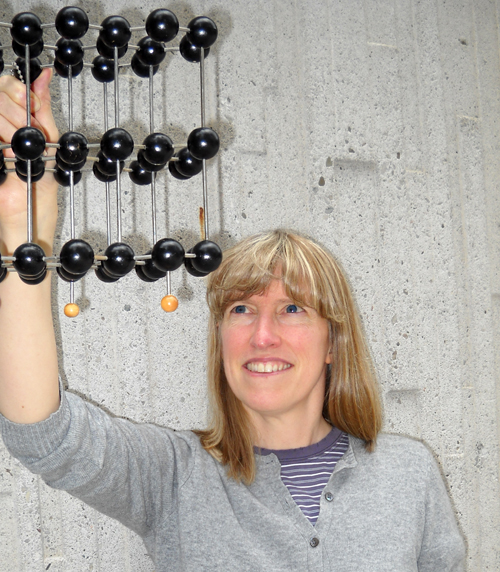
“It’s a miracle in two dimensions.” So says U of G physics professor Elisabeth Nicol about a hot new material that promises to alter such everyday products as computers, phones, solar cells, batteries, biosensors and even medical devices.
To find it, start with your pencil. Pencil “lead” consists of graphite, made up of layers and layers of carbon. Weak bonds allow graphite to be pulled apart easily as the pencil travels over paper. “As you write, bits flake off,” she says.
Most of those bits are just more graphite, but likely your pencil has deposited the odd morsel of graphene, too.
That graphene — Nicol’s 2D “miracle” — is a sheet of carbon only one atom thick. Those atoms link together in a regular latticework of honeycomb shapes resembling chicken wire. At that scale, the material takes on what the Guelph physicist calls “exotic quantum properties.”
The electrons in this two-dimensional crystal act as though they have no mass, akin to photons, or particles of light. “They run like crazy through the lattice,” says Nicol. That suggests the material could make a great electrical conductor for use in electronics.
Also a potential boon for phones or computer touch screens is graphene’s flexibility. “Imagine your computer if you could just roll it up.”
It’s lightweight, but it’s strong — even stronger than steel. Nicol says a square metre of the stuff could hold up a cat, even though the material would weigh no more than the cat’s whiskers. Mix graphene into plastic, and you get a stronger substance with electrical properties.
It would also allow electronics companies to make even smaller products without problems of interference and heat that plague silicon at miniature scales.
Another benefit: ubiquitous carbon would be cheaper than indium, a less common element now used for liquid crystal displays and touch screens. “Everything around us is carbon,” says Nicol.
No company has yet marketed a graphene-based product. But numerous patents have been taken out, and companies are working on potential applications.
Some have made prototypes of computer and tablet screens. One company is looking into rechargeable batteries no thicker than a human hair.
“There’s a lot of potential. There’s a lot of hype, but they’re making things pretty fast,” she says. Earlier this year, the European Commission pledged two billion euros to two promising research areas: the brain and graphene. Referring to Silicon Valley, she says, “They want to make Europe the ‘Graphene Valley.’”
Nicol expects the first graphene products on the market will be flexible phones or solar cells, along with batteries.
Nearly transparent, the material attracts some researchers for its optical properties. Maybe it could be used in artificial retinas to help restore sight, she says: “That’s near and dear to my heart, because my stepfather has macular degeneration.”
“There are new things all the time,” she adds. “There are a lot of people in the field. I spend an hour every morning looking at new papers. This is the way the field moves — it moves pretty fast, and I can’t miss a day. It’s exciting.”
It’s a hot new field for Nicol, too.
For years, she has studied superconductivity here at Guelph. She was drawn into graphene studies during a research leave six years ago by Jules Carbotte, a colleague at McMaster University.
She still studies superconductivity, but she’s spending more of her time on graphene. Nicol doesn’t work directly with the material. As a theorist, she runs calculations intended to help applied researchers predict results and test ideas for materials.
She’s also interested in other kinds of two-dimensional crystal materials. She has worked on silicene, for example, which resembles the honeycomb lattice of graphene but with silicon atoms instead of carbon. “We’re doing calculations to see what we could get out of the material.”
Calvin Tabert, a PhD student, works with her on silicene and bilayer graphene. Twisting layers against each other produces unusual behaviour and colour changes.
Shining light on the materials allows researchers to isolate a particular group of electrons and even harness their magnetic spin properties in an emerging field called spintronics.
Tabert has already published six research papers since beginning his master’s degree with Nicol. When he arrived at Guelph, he had been interested in relativity and particle physics. But he found himself caught up in the excitement of working with a new material.
“It’s kind of cool to work on stuff with a potential tech application,” he says. “We look for things that experimentalists could go out and verify.”
Two other grad students – Boris Pavlovic and John Malcolm – are studying two-dimensional crystals with graphene-like features in her lab; both completed undergrad degrees at Guelph.
Graphene was isolated in 2004 by physicists Andre Geim and Konstantin Novoselov at the University of Manchester.
Geim has worked on nanotechnology and superconductivity. In 2000, he shared the Ig Nobel Prize in physics (a parody of the Nobel Prize) for magnetically levitating a frog. He was also involved in developing “gecko tape,” an adhesive that mimics the “stickiness” of gecko feet on walls and ceilings.
Adhesive tape also played into the isolation of graphene. In a classic experiment, the physicists used the tape to pull away successive layers of graphite until only a single-atom layer of material was left.
Their work earned Geim and Novoselov the 2010 Nobel Prize in physics, giving the former an unusual claim to fame. Says Nicol: “He’s the only one who’s gotten both a Nobel and an Ig Nobel.”
Speaking of Geim as a role model, she says, “There is a sense of fun and imagination that’s very inspiring.”